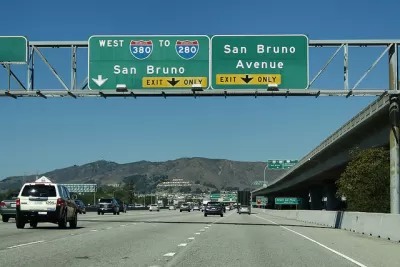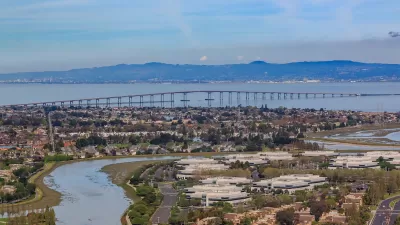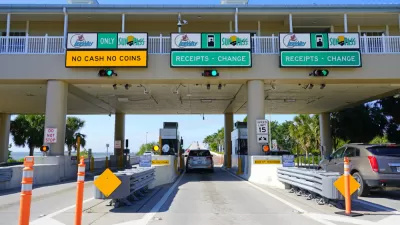State and county officials gathered on Friday to celebrate the start of a $514 million project to convert carpool lanes to express lanes and connect auxiliary lanes to make for a lane addition. The 32-mile project on Highway 101 opens in 2022.

"The 101 Express Lane Projects will deliver 32 miles of interrupted express lanes in both directions on U.S. 101 between Interstate 380 in San Bruno and State Route 237 in Sunnyvale," according to the Caltrans media advisory [pdf]. The most challenging part of the project, and its raison d'être, is to construct 14-15 miles of express lanes from Redwood City north to San Bruno, in both directions, where no carpool lanes exist.
Zachary Clark of the San Mateo Daily Journal has been reporting on the twists and turns of the controversial project within San Mateo County since its inception several years ago.
Managed Lanes construction will occur in two main phases. Between March and November of this year, the carpool lanes between the Whipple Avenue exit [in Redwood City south to] the Santa Clara County line will be converted to express lanes with tolling equipment.
Between October of this year and November of 2021, the new lanes will be constructed along with tolling infrastructure between the Whipple Avenue exit [north to] Interstate 380 [in San Bruno].
It's the latter part that is the most challenging as it involves connecting far right auxiliary lanes (that begin and end at entrances and exits, respectively) to create a continuous through lane, and then convert the far left lane into a new express lane that promises to bring relief to the fleets of tech company shuttles ferrying workers to Silicon Valley workplaces from San Francisco and elsewhere. This explains why Google and Facebook contributed funds to the project, along with three sources of public funding:
- Senate Bill 1, a 2017 bill that hiked gas taxes 12-cents per gallon that opponents unsuccessfully attempted to repeal last November.
- Regional Measure 3, a 9-county Bay Area ballot measure on June 5 that hiked tolls $3 over six years on the region's seven state-owned bridges.
- Measure W, a half-cent San Mateo County transportation sales tax measure that barely managed to reach the two-thirds threshold necessary for passage.
Dynamic tolling is expected to be applied to solo occupant vehicles using the express lanes which will free for carpools of three or more occupants as well as transit vehicles.
The tolled facility in San Mateo County is expected to generate $10 million to $20 million a year and that money must be reinvested into the corridor.
Part of the plan is to roll out an expanded network of express buses that will use the new lanes and officials hope many solo drivers will commute that way instead.
“We believe this is how you reduce congestion on freeways, by diverting carpools and buses and, if space is available, toll payers to an express lane,” said Maryann Moise Derwin, chair of City/County Association of Governments (C/CAG) and also a Portola Valley councilwoman.
The two biggest hurdles for officials in the two San Mateo County agencies, C/CAG and the Transportation Authority, that partnered with Caltrans in the project's planning, dealt with equity, i.e., the regressiveness of charging all solo drivers regardless of income the same toll, and ownership and operation of the express lanes.
The two agencies agreed to split ownership in the form of a joint powers authority and chose the Bay Area Infrastructure Financing Authority, also a joint powers authority between the Metropolitan Transportation Commission (MTC) and the Bay Area Toll Authority, to operate the facility.
The financing authority operates the I-680 Contra Costa Express Lanes which opened in October 2017, and has plans to operate "270 miles of the 600-mile Bay Area Express Lanes network; converting 150 miles of existing carpool lanes to Express Lanes and adding 120 miles of new lanes," according to MTC.
Derwin of C/CAG also saw the project as providing more than just congestion relief for commuters.
“This is how you change behavior, by encouraging people to drive in carpools or take express buses that fly through traffic. And because this is how you ultimately reduce greenhouse gases, by keeping cars moving at a steady speed.”
Caltrans hopes to continue express lane construction north of San Bruno into San Francisco, a project under consideration by the San Francisco County Transportation Authority.
Related in Planetizen: Public is Receptive to Plans for Express Lanes on Hwy 101 in Bay Area, December 16, 2017
FULL STORY: Managed Lanes breaks ground in San Mateo County

Trump Administration Could Effectively End Housing Voucher Program
Federal officials are eyeing major cuts to the Section 8 program that helps millions of low-income households pay rent.

Planetizen Federal Action Tracker
A weekly monitor of how Trump’s orders and actions are impacting planners and planning in America.

The 120 Year Old Tiny Home Villages That Sheltered San Francisco’s Earthquake Refugees
More than a century ago, San Francisco mobilized to house thousands of residents displaced by the 1906 earthquake. Could their strategy offer a model for the present?

Alabama School Forestry Initiative Brings Trees to Schoolyards
Trees can improve physical and mental health for students and commnity members.

NYC Outdoor Dining Could Get a Re-Do
The city council is considering making the al fresco dining program year-round to address cost concerns from small businesses.

HSR Reaches Key Settlement in Northern California City
The state’s high-speed rail authority reached an agreement with Millbrae, a key city on the train’s proposed route to San Francisco.
Urban Design for Planners 1: Software Tools
This six-course series explores essential urban design concepts using open source software and equips planners with the tools they need to participate fully in the urban design process.
Planning for Universal Design
Learn the tools for implementing Universal Design in planning regulations.
Ada County Highway District
Clanton & Associates, Inc.
Jessamine County Fiscal Court
Institute for Housing and Urban Development Studies (IHS)
City of Grandview
Harvard GSD Executive Education
Toledo-Lucas County Plan Commissions
Salt Lake City
NYU Wagner Graduate School of Public Service




























